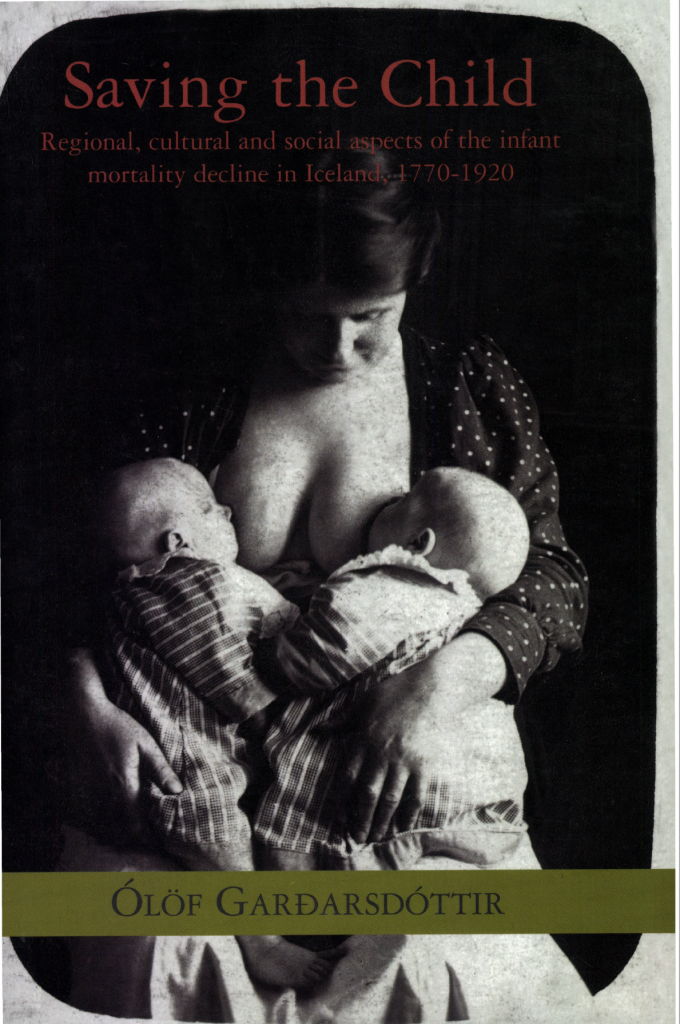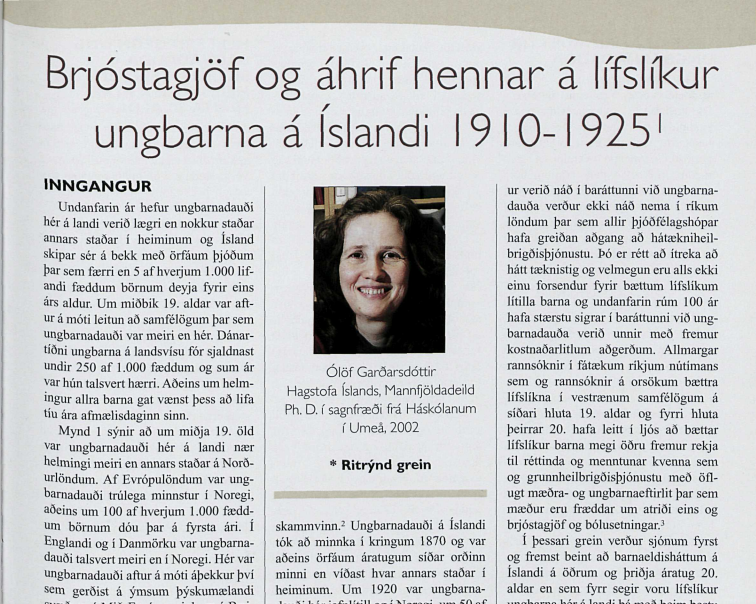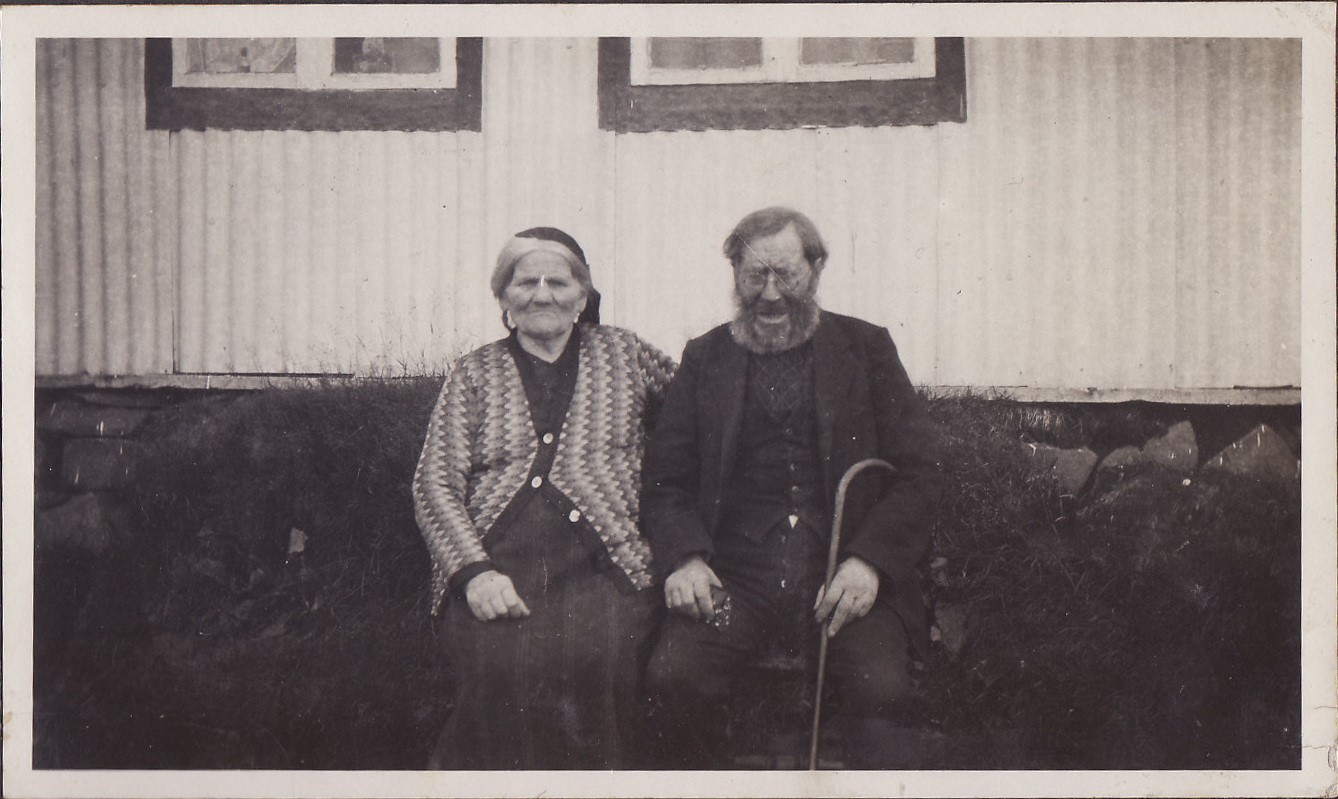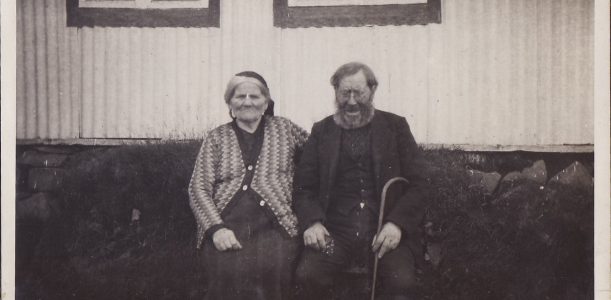Í doktorsritgerð Ólafar Garðarsdóttur við Umea háskólann í Svíþjóð “Saving the Child. Regional, Cultural and social aspects of the infant mortality decline in Iceland, 1770-1920” er að finna viðtal við Róshildi Sveinsdóttur um ömmu hennar Gyðríði Ólafsdóttur. Hér er ágrip af inngangi ritgerðarinnar – en hana má nálgast í heild sinni hér.
Hér fyrir neðan er einnig ágrip á íslensku úr Ljósmæðrablaðinu.
One of the most important persons of Róshildur’s childhood was her grandmother Gyðríður Ólafsdóttir, who served as a midwife in the local community.

In February 1911, a girl was born in the commune of Ásar in southern Iceland.
She was given the name Róshildur and grew up in a group of 15 siblings who
were born between 1904 and 1925. Her family was relatively well off and
occupied the largest holding in the parish. Róshildur was the seventh child of
her parents. Three of her siblings died in infancy, two of them were older than
Róshildur. What they died of is not given in the parish register of Ásar. According
to the parish registers however, one younger brother died of whooping cough
at the age of three months. Róshildur remembers the death of her younger
brother vividly and, in her mind, he died of barnaveiki (child-disease), a term
that is frequendy used for diphtheria in Iceland. Two other siblings were taken ill
by the disease, but survived with the help of a homeopath who was usually sent
for in the case of a disease in the family. Róshildur claims that he managed to
save the lives of many young children in the area. She recalls intense poverty in
many households of the commune with several families constantly facing the
threat of sudden death or illness.
One of the most important persons of Róshildur’s childhood was her grandmother
Gyðríður Ólafsdóttir, who served as a midwife in the local community.
Róshildur describes her as a loving person who cared for the poor and the
elderly. Gyðríður had in many ways experienced a childhood similar to that of
her granddaughter. She was born in 1844 in a parish east of Ásar and her
mother gave birth to 14 children of whom only eight survived their first birthday.
Gyðríður married in 1865 and her marriage too was an exceptionally fertile
one — like her mother she gave birth to 14 children. Despite frequent births,
she devoted herself to the vocation of midwifery during her fertile years. Like
many midwives of her generation, she did not receive any formal education in
midwifery, but was one of the wise women who were entrusted to carry out
the important task of helping women in childbirth. Midwifery was by no means
easy at that time. Like many other agrarian districts in Iceland, the area where
Ásar is situated was remote and sparsely populated and frequently midwives
had to travel long distances on horseback across turbulent rivers to attend to
childbirths. Usually midwives in sparsely populated areas stayed with childbearing
women for a few days after delivery as did Gyðríður. However, in the case
of destitute families, with a large number of young children, she used to take
the newborns home with her and cared for them in her own household for a
few weeks after delivery. The newborns were then given cow’s milk diluted
with boiled water. After a few weeks, the young child was taken back to his or
her family, equipped with a feeding-bottle and a set of new cloths donated by
the midwife. Grandmother Gyðríðurdelivered Róshildur and all her siblings
except for the two youngest (born in 1921 and 1925). None of the children
were ever breastfed and Róshildur maintains that breastfeeding was virtually
unknown in the commune when she grew up. The account of the midwife
taking newborns home with her certainly supports this.
Róshildur grew up as a sister of six younger siblings and her childhood
memories are filled with the upbringing and care of infants and young children.
She was frequently made responsible for minding her younger siblings and she
remembers vividly how she used to clean the feeding bottles. “This was by no
means an easy task since the milk tended to turn sour easily and then stick to the
bottle. Sometimes we used salt diluted in water to clean the bottles”, she recalls.
During her childhood glass bottles were most frequently used, but no rubber
teats were available in the district. Teats of wood were most common and in
Róshildur’s family wooden spools (used for cotton thread), were re-shaped and
used as teats. They were wrapped in wool and covered with linen when the
infant was fed.
When my informant Róshildur was born in 1911, Icelandic society was on
the threshold of a new era. People of her generation have, during their lifetime,
probably experienced more changes in the economic and social structure of the
country than any other. Until the late 19th Century, this society situated on the
periphery of the Danish kingdom, was extremely sparsely populated. The majority
of the population were tenant farmers of relatively scant means and most
inhabitants depended primarily on animal husbandry for their livelihood. However,
the fisheries formed an important subsidiary income in many areas. The
settlement pattern was characterized by scattered farms along the coast, with
the vast interior largely uninhabited.
At the beginning of the 20th Century, Icelandic society was slowly beginning
to enter the initial phase of a modernized society with an increasing national
product and a relatively complex infrastructure. The…

Ljósmæðrablaðið, 1. tbl. 83. árg. júní 2005
Ólöf Garðarsdóttir: Brjóstagjöf og áhrif hennar á lífslíkur ungbarna á Íslandi 1910-1925
Íslenskar ljósmæður að störfum
Sem fyrr segir benda samtímaheimildir frá því um miðbik 19. aldar til þess að brjóstagjöf hafi staðið hvað veikustum fótum í sveitum á Suðurlandi. Ein þeirra ómenntuðu yfirsetukvenna sem störfuðu við ljósmóðurstörf í þessum landshluta var Gyðríður Ólafsdóttir (1844-1933) en hún bjó lengst af í Ásum í Skaftártungu. Í viðtali sem ég tók við barnabarn Gyðríðar, Róshildi Sveinsdóttur árið 1999, lýsti hún ljósmóðurstörfum ömmu sinnar eins og hún minntist þeirra.
Róshildur var fædd árið 1911, sjöunda barnið í röð fimmtán systkina. Ljósan, amma hennar, var komið nokkuð til ára sinna þegar Róshildur fæddist og ný ljósmóðir, Elín Árnadóttir (1886-1973), hóf störf í sókninni nokkrum árum síðar. Þótt Gyðríður hefði látið af störfum um þetta leyti tók hún á móti barnabörnum sínum, að undanskildum tveimur yngstu sem fæddust 1921 og 1925. Að sögn Róshildar voru börn í sveitinni ekki lögð á brjóst og hún minntist þess glöggt þegar hún var látin þvo pela yngri systkina sinna. Algengast var að túttur væru úr tré, gjarnan tálguð tvinnakefli, sem síðan voru þakin með ullarþeli og vafin með léreftsgrisju.
Amma Róshildar átti það til að taka nýbura með sér heim þegar mjög fátækar fjölskyldur áttu í hlut. Þá hafði hún börnin hjá sér í 3-4 vikur á meðan móðirin lá á sæng. Frásögn Róshildar rennir stoðum undir vitnisburð sem finna má hjá samtímamönnum á 18. og 19. öld þar sem fram kemur að algengt hafi verið að ljósmæður tækju hvítvoðunga með sér heim. Hér var greinilega um að ræða leið til að létta undir með fátækum fjölskyldum í dreifbýlu samfélagi þar fjölskyldur áttu þess ekki alltaf kost að leita til nágranna eða ættmenna meðan móðir lá á sæng. Ljósmæður voru yfirleitt sjálfar húsmæður í sveit og höfðu fyrir eigin börnum að sjá. Oft á tíðum hafa þær ekki getað dvalið eins lengi hjá sængurkonum og þær hefðu kosið.
… Af ljósmæðraskýrslum má sjá að ljósmóðirin sem tók við af ömmu Róshildar tileinkaði sér aðra starfshætti en fyrirrennari hennar. Á tímabilinu 1915-1925 tók hún á móti 16 börnum og samkvæmt skýrslum hennar voru 10 þeirra lögð á brjóst. Hún tók á móti tveimur yngstu systkinum Róshildar og ljósmæðraskýrslur hennar sýna að þau voru bæði alin á pela frá fæðingu. Þetta þarf í sjálfu sér ekki að koma á óvart. Í samfélagi þar sem löng hefð var fyrir því að ala börn á annarri fæðu en brjóstamjólk verður að teljast eðlilegt að elstu mæðurnar kysu að halda áfram fyrri háttum og gefa börnum sínum pela í stað brjósts. Það verður líka að teljast harla ólíklegt að það hafi hvarflað að ungum og óreyndum ljósmæðrum að reyna að hafa vit fyrir reyndum mæðrum. Móðir Róshildar var hreppstjórafrú, komin yfir fertugt þegar hún átti yngstu börnin sín tvö og ljósmóðirin hefur tæpast talið það í sínum verkahring að ráðleggja sér miklu eldri konu um banaeldi eða uppeldi yfir höfuð.
Úr bók Þórðar Tómassonar í Skógum, Listaætt á Austursveitum:
„Gyðríður var í öllu manni sínum samboðin, orðlögð öndvegiskona. Hún var ljósmóðir og ætíð tók hún ljósubörn sín heim með sér við fæðingu til hálfs mánaðar dvalar. Ósmátt var það sem hún lagði í heimili fátæks fólks í mat eða klæðum og hafði þó jafnan fyrir stóru heimili að sjá.“
Grein Ólafar er að finna í fullri lengd hér: https://timarit.is/page/5449372?iabr=on#page/n21/mode/2up

